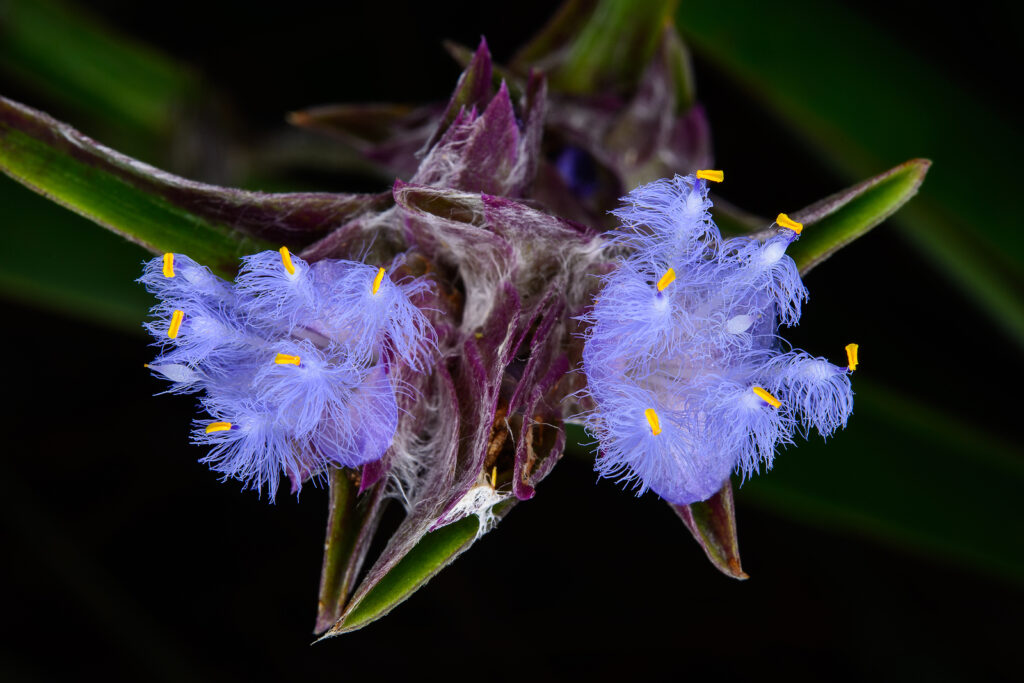Cyanotis–commonly called teddy bear plant or pussy ears–is a low-growing, compact creeping evergreen plant native to tropical forests in Africa and Asia. It is grown as a houseplant in temperate regions.
Cyanotis grows to about 5 inches (12cm) tall and 12 to 16 inches (30-40cm) wide. The leaves may be oval or triangular; they are dark green above and red beneath. The leaves are covered with short, felted brown hairs.
Cyanotis bears short-lived, shallowly cup-shaped 3-petaled flowers that can be purple, violet, or blue. Flowers appear in summer.
Cyanotis is a genus of about 30 species of low-growing, evergreen perennials. Cyanotis is related to the genus Tradescantia; it is more succulent and has a tolerance for dry conditions.
Get to know Cyanotis
- Plant type: Evergreen perennial
- Growing zones and range: Zones 13-15
- Hardiness: Tender
- Optimal growint temperature: day, 65° to 70°F (18° to 21°C). Cooler at night.
- Height and width: 5 to 6 inches (12-15cm) tall, 12 to 16 inches (30-40cm) wide.
- Foliage: Lance-shaped to broadly ovate or oblong leaves, dark green above, red beneath, densely covered with short, felted, ginger brown hairs.
- Flowers: Shallowly cup-shaped, 3-petaled purple, violet, or blue flowers
- Bloom time: Summer
- Uses: Houseplant, hanging baskets, in tropical regions plant in an herbaceous bed or border
- Common name: Pussy ears, teddy bear plant
- Botanical name: Cyanotis
- Family name: Commelinaceae
- Origin: Rocky areas in Africa and Asia

Where to plant Cyanotis
- Light outdoors: Full sun with some midday shade.
- Light indoors: Full sun from eastern or western exposure. Teddy bear plant requires direct light,
- Soil outdoors: Moderatly fertile, well-drained soil.
- Soil indoors: Use an all-purpose soil mix.
- Cyanotis can tolerate dry conditions.
When to plant Cyanotis
- Set Cyanotis outdoors any time of the year in tropical regions.
Planting and spacing Cyanotis
- Space Cyanotis 12 to 16 inches (30-40cm) apart.
How to water and feed Cyanotis
- Water: Keep the soil evenly moist; allow the soil to dry moderately between waterings. . Humidity at about 35% is best.
- Feeding: Fertilizer should be applied once or twice in spring or summer; use a mild liquid fertilizer.
Cyanotis care
- Established plants rarely need repotting.
- Excessive feeding can cause untypical growth.
Growing Cyanotis as a houseplant
- Cyanotis requires direct light, average temperature, and very high humidity.
- Do not mist Cyanotis; direct application of moisture can damage the hairy leaves.
- The soil should be allowed to dry moderately between waterings.
- Fertilizer should be applied once or twice in spring and summer.
Cyanotis pests and diseases
- Cyanotis bear plant can be damaged by aphids and mealybugs.
Cyanotis propagation
- Cyanotis can be propagated by stem cuttings that include at least three pairs of leaves. The cuttings should be planted in an all-purposed soil mix.
Cyanotis varieties to grow
- Cyanotis kewensis, teddy bear plant. Trailing plant with gray-green leaves with purple underside; leaf hairs are reddish brown.
- C. somaliensis, pussy ears. Shiny green foliage covered with long white hairs.















